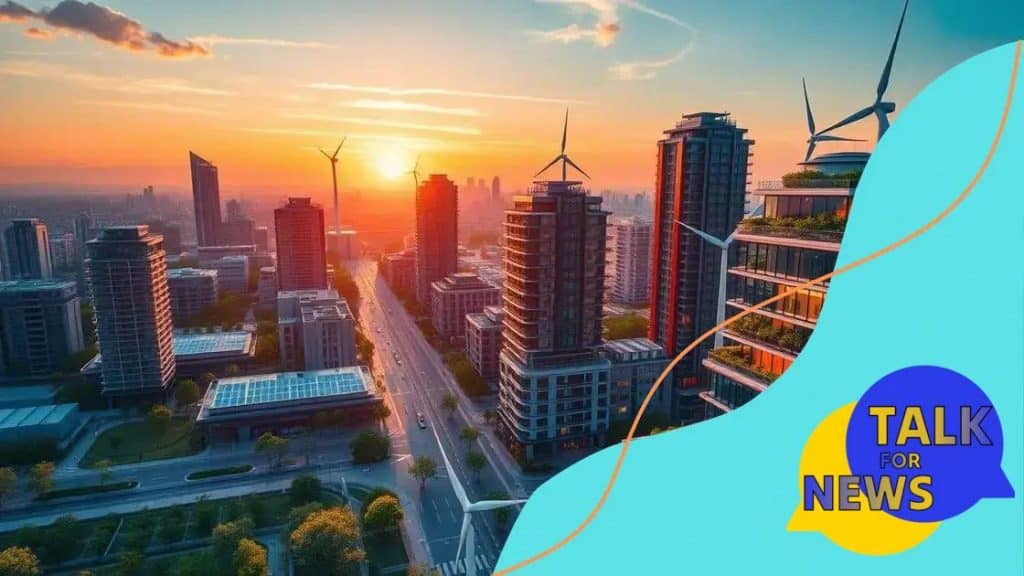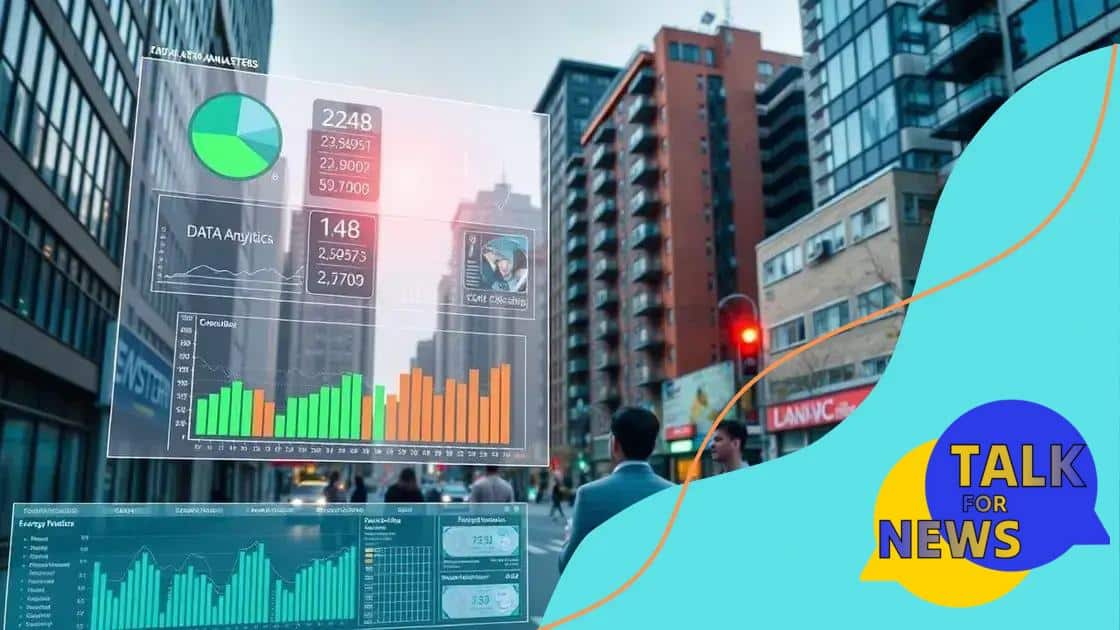How smart cities are using technology to reduce energy consumption

Anúncios
Smart cities utilize innovative technologies, such as smart lighting and renewable energy sources, to significantly reduce energy consumption and enhance sustainability, while improving residents’ quality of life.
How smart cities are using technology to reduce energy consumption is a question more relevant than ever. With urban areas growing, cities are embracing tech to save energy and costs. Let’s dive into how this transformation is shaping our lives.
Anúncios
Understanding smart cities and their technology
Understanding smart cities and their technology involves grasping how urban environments use cutting-edge tools to enhance the quality of life. Smart cities leverage technology to manage resources efficiently, improve services, and reduce environmental impact. This integration of technology makes daily operations smoother for residents and enables municipalities to tackle issues like traffic congestion and energy consumption effectively.
The backbone of smart cities
The technology that supports smart cities is multifaceted. These cities often implement:
- IoT devices: These sensors collect data on various aspects, such as traffic patterns and energy usage.
- Data analytics: Analyzing data helps identify trends and optimize city services.
- Renewable energy sources: Solar and wind energy are commonly integrated to reduce carbon footprints.
- Smart grids: These enhance energy distribution efficiency, allowing for real-time adjustments based on consumption.
Anúncios
Around the world, cities like Barcelona and Singapore exemplify how technology can transform urban spaces. For instance, Barcelona uses smart lighting systems that adjust based on human presence, reducing energy waste at night. Meanwhile, Singapore employs data analytics in public transportation, allowing for better service frequency and reduced wait times.
Challenges in implementation
Despite the benefits, adopting technology in cities poses challenges. Issues such as data privacy, infrastructure costs, and the need for community engagement are significant hurdles. City planners must consider these factors to ensure that smart city technologies are inclusive and beneficial for all citizens.
In conclusion, understanding smart cities and their technology reveals a promising path towards more sustainable living. By harnessing smart technologies, cities can operate more intelligently, paving the way for a better future for urban populations.
Energy-saving technologies adopted by smart cities
Energy-saving technologies adopted by smart cities play a crucial role in minimizing energy consumption and promoting sustainability. These innovations assist communities to not only cut costs but also protect the environment. Cities worldwide are implementing various technologies designed to improve energy efficiency in buildings, transportation, and infrastructure.
Smart lighting systems
One of the primary innovations is the use of smart lighting. These systems adjust brightness based on natural light and human activity, significantly reducing energy use. For instance, some cities utilize LEDs that can be remotely controlled.
- Adjusts to natural light
- Remote monitoring capabilities
- Significantly lowers energy consumption
- Improves safety with better visibility
Smart lighting is not only energy-efficient but also enhances public safety by ensuring well-lit streets during dark hours.
Energy-efficient buildings
Smart cities also invest in energy-efficient buildings. These structures are designed with insulation, energy-efficient appliances, and smart meters that monitor energy usage in real-time. The integration of renewable energy sources like solar panels further contributes to their sustainability.
Using green rooftops and high-performance windows helps to maintain indoor temperatures, significantly reducing heating and cooling needs.
Public transportation innovations
Another critical area is public transportation. Electric buses and trains are becoming increasingly common in smart cities. These alternatives reduce reliance on fossil fuels, leading to lower emissions. Additionally, some cities use real-time data to optimize transit routes and schedules, enhancing efficiency and encouraging people to use public transport.
Additionally, bike-sharing programs are often implemented, promoting environmentally-friendly transportation methods. As a result, urban areas experience reduced traffic congestion while also encouraging a healthier lifestyle.
The shift towards using renewable energy in smart cities also includes the development of smart grids. These technologies allow for more efficient energy distribution and are capable of adjusting supply based on real-time demand, preventing energy waste.
The role of data analytics in energy management

The role of data analytics in energy management is transforming how cities approach energy efficiency. By harnessing data, urban planners can make informed decisions that lead to significant reductions in energy consumption. This technology allows cities to monitor usage patterns, identify inefficiencies, and predict future energy needs, creating smarter, more sustainable urban environments.
Real-time energy monitoring
One of the key benefits of data analytics is real-time monitoring. This involves collecting data continuously from various sources, such as smart meters and IoT devices. By analyzing this data, cities can:
- Identify peak usage times
- Detect unusual consumption patterns
- Optimize energy distribution
- Adjust services accordingly
This real-time insight enables energy providers to react quickly to fluctuations in demand, ensuring that the grid remains stable and efficient.
Predictive analytics
Another vital aspect is the use of predictive analytics. By examining historical energy data, algorithms can forecast future energy needs. This helps in planning for seasonal changes and unexpected spikes in demand. For example, cities can:
- Anticipate increased usage during extreme weather
- Optimize energy resources ahead of time
- Reduce reliance on fossil fuels by increasing renewable sources during high demand
As a result, cities can create strategies that enhance sustainability while meeting the needs of their residents.
Data analytics also supports smarter infrastructure investments. Understanding usage patterns helps city planners design energy-efficient buildings and public spaces. With precise data, they can prioritize projects that provide the highest returns on energy savings.
Moreover, engaging citizens through data transparency empowers them to make informed choices about energy consumption. Initiatives like informative dashboards and alerts encourage residents to reduce their energy usage. This participatory approach fosters a collective responsibility for managing energy resources.
Innovative practices from global smart cities
Innovative practices from global smart cities highlight how different urban areas adapt technology to improve quality of life. Cities around the world are experimenting with unique solutions to tackle common challenges such as traffic congestion, energy consumption, and public safety.
Barcelona’s smart solutions
In Barcelona, the innovative use of smart sensors has transformed urban infrastructure. These sensors assist in monitoring air quality, traffic flow, and even noise levels. This data allows the city to respond quickly to environmental changes, optimizing public space usage and enhancing residents’ comfort.
- Real-time air quality monitoring
- Smart traffic lights that adjust in response to congestion
- Improved waste management with smart bins
These features help in creating a cleaner, more efficient city.
Singapore’s digital advancements
Singapore is recognized for its comprehensive use of technology to ensure efficient public transport. The city-state employs big data analytics to optimize train and bus schedules based on passenger demand. This system reduces wait times and enhances the overall travel experience.
Moreover, their extensive network of surveillance cameras integrated with AI technology ensures public safety, enabling faster responses to incidents.
Amsterdam’s sustainable innovations
Amsterdam leads in sustainability practices with its focus on green energy and cycling infrastructure. The city promotes renewable energy sources and has invested heavily in smart electric vehicle (EV) charging stations.
- Extensive bike-sharing programs
- Smart charging stations for EVs
- Public campaigns to reduce carbon footprints
These initiatives not only enhance urban mobility but also contribute to a healthier environment.
Additionally, cities like Dubai are experimenting with blockchain technology for efficient management of municipal services, showcasing how digital solutions can streamline operations and enhance transparency. Innovations like these are invaluable in adapting to ongoing urban challenges.
Future trends in energy efficiency for urban areas
Future trends in energy efficiency for urban areas are shaping how cities develop and grow. As the world becomes more urbanized, the need for sustainable solutions rises, prompting innovations across various sectors. This includes advancements in technology, design, and policy that aim to reduce energy consumption.
Smart technologies and automation
One significant trend is the increased use of smart technologies. These systems harness data and automation to enhance energy efficiency. For example, smart thermostats and lighting can adjust settings based on real-time occupancy and usage patterns. This level of automation reduces energy waste, allowing residents to lower their utility bills.
- Automated building management systems
- Energy-efficient appliances with smart integrations
- Sensors to monitor and reduce waste
These technologies not only save energy but also improve the comfort of living spaces.
Renewable energy integration
Another important trend is the integration of renewable energy sources. Many urban areas are investing in solar panels and wind turbines, becoming less reliant on fossil fuels. Cities are increasingly implementing community solar projects that allow multiple households to benefit from shared solar energy. This collective approach to renewable energy generation makes it accessible and economically viable for all.
The shift to renewable sources means cities can significantly reduce their carbon footprint while promoting sustainability and reducing costs over time.
Sustainable urban planning
Sustainable urban planning is also evolving. Cities are focusing on creating green spaces and energy-efficient buildings. Urban planners are designing spaces that incorporate nature, which helps regulate temperature and improve air quality. These designs include:
- Green roofs and walls
- Eco-friendly materials in construction
- Efficient public transportation systems to reduce vehicle emissions
As a result, urban areas can become more livable and environmentally friendly.
Furthermore, upcoming policies and regulations are aiming to encourage energy-efficient practices through incentives. Many governments are offering tax breaks or subsidies for energy-saving technologies, bringing them within reach for more residents and businesses. This shift towards policy support is crucial for fostering a culture of sustainability in urban settings.
FAQ – Frequently Asked Questions about Energy Efficiency in Smart Cities
What are smart technologies and how do they improve energy efficiency?
Smart technologies include devices that automate energy consumption, such as smart thermostats and lights. They adjust usage based on real-time data, reducing waste and costs.
How can cities integrate renewable energy sources effectively?
Cities can invest in solar panels, wind turbines, and community solar projects. This helps reduce reliance on fossil fuels and lower carbon emissions.
What role does sustainable urban planning play in energy efficiency?
Sustainable urban planning focuses on green spaces and energy-efficient buildings, which enhance air quality and reduce energy consumption, creating healthier environments.
How can policies support energy-saving practices in urban areas?
Policies can provide incentives like tax breaks or subsidies for energy-efficient technologies, encouraging individuals and businesses to adopt sustainable practices.





